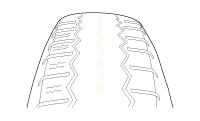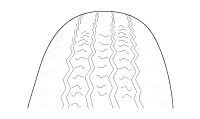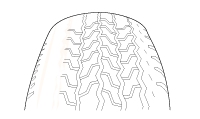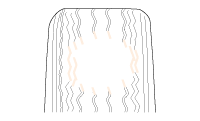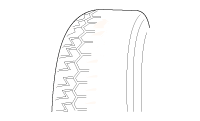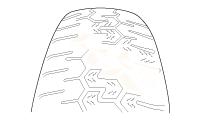 Kia Sedona: Troubleshooting
Kia Sedona: Troubleshooting
Third generation YP (2014-2026) / Kia Sedona YP Service Manual / Suspension System / Troubleshooting
| Troubleshooting |
Vehicle inspection
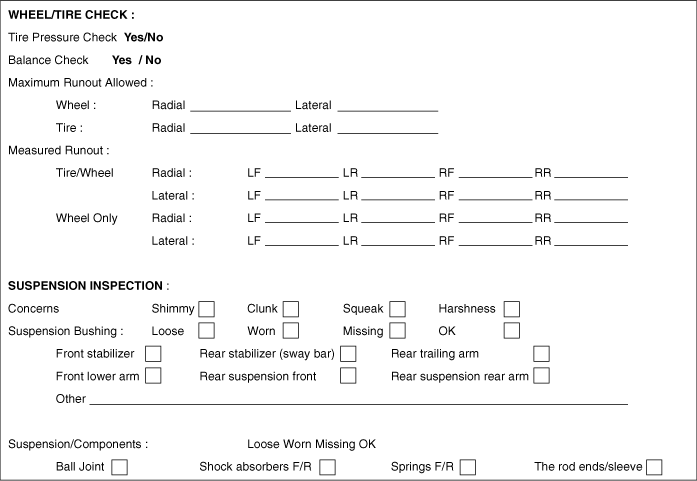
SYMPTOM CHART
| Symptom | Suspect Area | Remedy (See page) |
| Squeak
or grunt-noise from the front suspension, occurs more in cold ambient
temperatures-more noticeable over rough roads or when turning | Front stabilizer bar | Under these conditions, the noise is acceptable. |
| Clunk-noise from the front suspension, occurs in and out of turns | Loose front struts or shocks | Inspect for loose nuts or bolts. Tighten to specifications. |
| Clunk-noise from the rear suspension, occurs when shifting from reverse to drive | Loose rear suspension components | Inspect for loose or damaged rear suspension components. Repair or install new components as necessary. |
| Click or pop - noise from the front suspension, more noticeable over rough roads or over bumps | Worn or damaged ball joints | Install new lower arm as necessary. |
| Click or pop - noise occurs when vehicle is turning | Worn or damaged ball joints | Install new lower arm as necessary. |
| Click or snap - occurs when accelerating around a corner | Damaged or worn Birfield joint | Repair or install a new Birfied joint as necessary. See DS group - driveshaft. |
| Front suspension noise - A squeak, creak, or rattle noise - occurs mostly over bumps or rough roads | Steering components Loose or bent front struts or shock absorbers Damaged spring or spring mounts Damaged or worn arm bushings Worn or damaged stabilizer bar bushing or links | Go to detailed test A. |
| Groaning or grinding - noise from the front strut, occurs when driving on bumpy roads or turning the vehicle | Uneven
seating surface between the insulator and panel by the burrs around the
strut insulator mounting bolts and the insulator boltes mounting holes | Repair or install a new parts as necessary. |
| Rear suspension noise - a squeak, creak or rattle noise - occurs mostly over bumps or rough roads | Loose or bent rear shock absorbers Damaged spring or spring mounts Damaged or worn control arm bushings | Go to detailed test B. |
| Shudder - occurs during acceleration from a slow speed or stop | Rear axle assembly mis-positioned Damaged or worn front suspension components | Check the axle mounts and rear suspension for damage or wear. Repair as necessary. Check for a loose stabilizer bar, damaged or loose strut/strut bushings or loose or worn ball joints. Inspect the steering linkage for wear or damage. Repair or Install new components as necessary. |
| Shimmy - most noticeable on coast/deceleration - also hard steering condition | Excessive positive caster | Check the caster alignment angle. Correct as necessary. |
| Tire noise - hum/moan at constant speeds | Abnormal wear patterns | Spin
the tire and Check for tire wear. Install a new tire as necessary.
Inspect for damaged/worn suspension components. Perform wheel alignment. |
| Tire noise - noise tone lowers as the vehicle speed is lowered | Out-of-balance tire | Balance the tire and road test. Install a new tire as necessary. |
| Tire noise - ticking noise, change with speed | Nail puncture or stone in tire tread | Inspect the tire. Repair or replace as necessary. |
| Wheel
and tire - vibration and noise concern is directly related to vehicle
speed and is not affected by acceleration, coasting or decelerating | Damaged or worn tire | Go to detailed test C. |
| Tire wobble or shudder - occurs at lower speeds | Damaged wheel bearings | Spin the tire and check for abnormal wheel bearing play or roughness. Adjust or Install new wheel bearings as necessary. See DS group - front/rear axle. |
| Damaged wheel | Inspect the wheel for damage. Install a new wheel as necessary. | |
| Damaged or worn suspension components | Inspect the suspension components for wear or damage. Repair as necessary. | |
| Loosen wheel nuts | Check the wheel nuts. Tighten to specification. | |
| Damaged or uneven tire wear | Spin the tire and Check for abnormal tire wear or damage. Install a new tire as necessary. | |
| Tire shimmy or shake - occurs at lower speeds | Wheel/tire out of balance | |
| Uneven tire wear | Check for abnormal tire wear. Install a new tire as necessary. | |
| Excessive radial runout of wheel or tire | Perform a radial runout test of the wheel and tire. Install a new tire as necessary. | |
| Worn or damaged wheel studs or elongate stud holes | Inspect the wheel studs and wheels. Install new components as necessary. | |
| Excessive lateral runout of the wheel or tire | Perform a lateral runout test of the wheel and tire. Check the wheel, tire and hub. Repair or Install new components as necessary. | |
| Foreign materal between the brake disc and hub. | Clean the mounting surfaces of the brake disc and hub. See DS group - front/rear axle. | |
| High speed shake or shimmy - occurs at high speeds | Excessive wheel hub runout Damaged or worn tires Damaged or worn wheel bearings Worn or damaged suspension or steering linkage Brake disc or drum imbalance | Go to detailed test D. |
| Drift left or right | Tires Steering linkage Alignment Base brake system | Go to detailed test E. |
| Steering wheel | Alignment Steering linkage Front lower arm ball joint | Go to detailed test F. |
| Tracks incorrectly | Rear suspension Caster | Go to detailed test G. |
| Rough ride | Front strut and spring assembly Rear shock absorber and spring assembly | Go to detailed test H. |
| Excessive noise | Front or rear stabilizer bar components Springs Suspension components Shock absorbers | Go to detailed test I. |
| Incorrect tire wear | Tire or unbalanced wheels Tire inflation Strut Alignment | Go to detailed test J. |
| Vibration | Wheel/tire Front wheel driveshaft(s) Steering system Strut and spring assembly Spring and strut mounting Front lower arm ball joint Front lower arm mounting bolt bushing Stabilizer bar bushings Wheel hubs and bearing Rear suspension arms and bushings | Go to detailed test K. |
| Vehicle leans | Tire/wheel Vehicle load Suspension components Incorrect ride height | Inflate tires to specification. Redistribute the load as necessary. Visually inspect the suspention system. Correct the ride height as necessary. |
| Poor steering returnability | High knuckle rotating torque Alignment | Go to detailed test E. |
DETAILED TEST A : FRONT SUSPENSION NOISE
| CONDITIONS | DETAILS/RESULTS/ACTIONS | ||||||
| A1. ROAD TEST THE VEHICLE | |||||||
| |||||||
| A2. INSPECT THE STEERING SYSTEM | |||||||
| |||||||
| A3. FRONT SHOCK ABSORBER/STRUT CHECK | |||||||
| |||||||
| A4. CHECK THE FRONT SPRINGS | |||||||
| Check the front spring and front spring mounts/brackets for wear or damage ● Are the front springs or spring mounts/brackets worn or damaged ? → YES Repair or Install new components as necessary. Test the system for normal operation. → NO Go to A5. | |||||||
| A5. CHECK THE STABILIZER BAR | |||||||
| |||||||
DETAILED TEST B : REAR SUSPENSION NOISE
| CONDITIONS | DETAILS/RESULTS/ACTIONS | ||||||
| B1. ROAD TEST THE VEHICLE | |||||||
| |||||||
| B2. REAR SHOCK ABSORBER/STRUT CHECK | |||||||
| |||||||
| B3. CHECK THE REAR SPRINGS | |||||||
| Check the rear springs and rear spring mounts/brackets for wear or damage. ● Are the rear springs or spring mounts/brackets worn or damaged ? → YES Repair or Install new components as necessary. Test the system for normal operation. → NO Go to B4. | |||||||
| B4. CHECK THE TRAILING ARMS | |||||||
| |||||||
DETAILED TEST C : WHEEL AND TIRE
| CONDITIONS | DETAILS/RESULTS/ACTIONS | ||||||
| C1. ROAD TEST THE VEHICLE | |||||||
● Is there a vibration and noise ? → YES Go to C2. → NO The wheel and tires are OK. Conduct a diagnosis on other suspect systems. | |||||||
| C2. CHECK THE FRONT WHEEL BEARINGS | |||||||
| Check the front wheel bearings. Refer to Wheel Bearing Check (See DS group - front axle). ● Are the wheel bearings OK ? → YES Go to C3. → NO Inspect the wheel bearings. Adjust or Repair as necessary. Test the system for normal operation. | |||||||
| C3. INSPECT THE TIRES | |||||||
| |||||||
| C4. TIRE ROTATION DIAGNOSIS | |||||||
| |||||||
| C5. RADIAL RUNOUT CHECK ON THE TIRE | |||||||
| Measure
the radial runout of the wheel and tire assembly. A typical
specification for total radial runout is 1.15mm (0.059 inch). ● Is the radial runout within specifications ? → YES Go to C8. → NO Go to C6. | |||||||
| C6. RADIAL RUNOUT CHECK ON THE WHEEL | |||||||
| Measure the radial runout of the wheel. A typical specification for total radial runout is 1.14mm (0.045 inch.). ● Is the radial runout within specifications ? → YES Install a new tire. Test the system for normal operation. → NO Go to C7. | |||||||
| C7. CHECK THE HUB/BRAKE DISC OR DRUM PILOT RUNOUT OR BOLT CIRCLE RUNOUT | |||||||
| Measure the pilot or bolt circle runout. A typical specification for radial runout is : ● pilot runout - less than 0.15mm (0.006 inch.) ● bolt circle runout - less than 0.38 mm (0.015 inch.) ● Is the radial runout within specification ? → YES Install a new wheel. Test the system for normal operation. → NO Repair or Install new components as necessary. | |||||||
| C8. LATERAL RUNOUT CHECK ON THE TIRE | |||||||
| Measure
the lateral runout of the wheel and tire assembly. A typical
specification for total lateral runout is 2.5mm (0.098 inch). ● Is the lateral runout within specifications ? → YES Wheel and tires are OK. Conduct diagnosis on other suspect systems. → NO Go to C9. | |||||||
| C9. LATERAL RUNOUT CHECK ON THE WHEEL | |||||||
| Measure the lateral runout of the wheel. A typical specification for total radial runout is 1.2mm (0.047 inch.) ● Is the lateral runout within specifications ? → YES Install a new tire. Test the system for normal operation. → NO Go to C10. | |||||||
| C10. CHECK THE FLANGE FACE LATERAL RUNOUT | |||||||
| Measure the flange face lateral runout. A typical specification for lateral runout is : ● hub/brake disc - less than 0.13mm (0.005 inch) ● Is the lateral runout within specifications ? → YES Install a new wheel. Test the system for normal operation. → NO Repair or Install new components as necessary. | |||||||
DETAILED TEST D :
| CONDITIONS | DETAILS/RESULTS/ACTIONS | ||||
| D1. CHECK FOR FRONT WHEEL BEARING ROUGHNESS | |||||
| |||||
| D2. CHECK THE END PLAY OF THE FRONT WHEEL BEARINGS | |||||
| Check the end play of the front wheel bearings. ● Is the end play OK ? → YES Go to D3. → NO Adjust or Repair as necessary. Test the system for normal operation. | |||||
| D3. MEASURE THE LATERAL RUNOUT AND THE RADIAL RUNOUT OF THE FRONT WHEELS ON THE VEHICLE | |||||
| Measure the lateral runout and the radial runout of the front wheels on the vehicle. Go to detailed test C. ● Are the measurements within specifications ? → YES Go to D4. → NO Install new wheels as necessary and Balance the assembly. Test the system for normal operation. | |||||
| D4. MEASURE THE LATERAL RUNOUT OF THE FRONT TIRES ON THE VEHICLE | |||||
| Measure the lateral runout of the front tires on the vehicle. Go to detailed test C. ● Is the runout within specifications ? → YES Go to D5. → NO Install new tires as necessary and Balance the assembly. Test the system for normal operation. | |||||
| D5. MEASURE THE RADIAL RUNOUT OF THE FRONT TIRES ON THE VEHICLE | |||||
| Measure the radial runout of the front tires on the vehicle. Go to detailed test C. ● Is the runout within specifications ? → YES Balance the front wheel and tire assemblies. If any tire cannot be balanced, Install a new tire. Test the system for normal operation. → NO Go to D6. | |||||
| D6. MATCH MOUNT THE TIRE AND WHEEL ASSEMBLY | |||||
| Mark
the high runout location on the tire and also on the wheel. Break the
assembly down and rotate the tire 180 degrees (halfway around) on the
wheel. Inflate the tire and measure the radial runout. ● Is the runout within specifications ? → YES Balance the assembly. Test the system for normal operation. → NO If the high spot is not within 101.6mm (4 inches) of the first high spot on the tire, Go to D7. | |||||
| D7. MEASURE THE WHEEL FLANGE RUNOUT | |||||
| Dismount the tire and mount the wheel on a wheel balancer. Measure the runout on both wheel flanges. Go to detailed test C ● Is the runout within specifications ? → YES Locate and Mark the low spot on the wheel. Install the tire, matching the high spot on the tire with the low spot on the wheel. Balance the assembly. Test the system for normal operation. If the condition persists, Go to D8. → NO Install a new wheel. Check the runout on the new wheel. If the new wheel is within limits, locate and Mark the low spot. Install the tire, matching the high spot on the tire with the low spot on the wheel. Balance the assembly. Test the system for normal operation. If the condition persists, Go to D8. | |||||
| D8. CHECK FOR VIBRATION FROM THE FRONT OF THE VEHICLE | |||||
| Spin
the front wheel and tire assemblies with a wheel balancer while the
vehicle is raised on a hoist. Feel for vibration in the front fender or
while seated in the vehicle. ● Is the vibration present ? → YES Substitute known good wheel and tire assemblies as necessary. Test the system for normal operation. → NO Check the driveline components. Test the system for normal operation. | |||||
DETAILED TEST E : DRIFT LEFT OR RIGHT
| CONDITIONS | DETAILS/RESULTS/ACTIONS | ||||
| E1. CHECK THE TIRES | |||||
| Inspect the tires for excessive wear or damage. ● Are the tires excessively worn or damaged ? → YES Install new tires. → NO Go to E2. | |||||
| E2. CHECK THE STEERING LINKAGE | |||||
| |||||
| E3. CHECK THE VEHICLE ALIGNMENT | |||||
| |||||
| E4. BRAKE DRAG DIAGNOSIS | |||||
| Apply the brakes while driving. ● Does drift or pull occur when the brakes are applied ? → YES See BR group - specification. → NO If the steering wheel is in the center, the vehicle is OK. If the steering wheel is off-center, Go to Detailed Test F. | |||||
DETAILED TEST F : STEERING WHEEL OFF-CENTER
| CONDITIONS | DETAILS/RESULTS/ACTIONS | ||||
| F1. CHECK THE CLEAR VISION | |||||
| Place the vehicle on an alignment rack. ● Is the clear vision within specification ? → YES Go to F2. → NO Adjust the clear vision to specification. | |||||
| F2. INSPECT THE STEERING COMPONENTS | |||||
| |||||
DETAILED TEST G : TRACKS INCORRECTLY
| CONDITIONS | DETAILS/RESULTS/ACTIONS | ||||
| G1. CHECK THE CASTER | |||||
| Place the vehicle on an alignment rack. ● Is the caster within specification ? → YES Go to G2. →NO Replace bent or damaged parts. | |||||
| G2. CHECK THE REAR SUSPENSION | |||||
| |||||
DETAILED TEST H : ROUGH RIDE
| CONDITIONS | DETAILS/RESULTS/ACTIONS | ||||
| H1. CHECK THE FRONT SHOCK ABSORBER | |||||
| |||||
| H2. CHECK THE REAR SHOCK ABSORBERS | |||||
| Inspect the rear shock absorbers for oil leaks or damage. ● Are the rear shock absorbers leaking ? → YES Install new rear shock absorbers. → NO The vehicle is OK. Go to TROUBLESHOOTING. | |||||
DETAILED TEST I : EXCESSIVE NOISE
| CONDITIONS | DETAILS/RESULTS/ACTIONS | ||||
| I1. INSPECT THE SUSPENSION | |||||
| |||||
| I2. INSPECT THE SPRING AND TORSION BARS | |||||
| Inspect the springs and stabilizer bars for damage. ● Are the spring or stabilizer bars damaged ? → YES Install new spring and/or stabilizer bars. → NO Go to I3. | |||||
| I3. INSPECT THE FRONT SUSPENSION | |||||
| Inspect the front suspension components for excessive wear or damage. ● Are the front suspension components worn or damaged ? → YES Install new front suspension components. → NO The vehicle is OK. Go to TROUBLESHOOTING. | |||||
DETAILED TEST J : INCORRECT TIRE WEAR
| CONDITIONS | DETAILS/RESULTS/ACTIONS | ||||
| J1. INSPECT THE TIRES | |||||
| |||||
| J2. UNEVEN TIRE WEAR | |||||
| Inspect the tires for a feathering pattern. ● Do the tires have a feathering pattern ? → YES Align the vehicle. Install new tires if badly worn. → NO Go to J3. | |||||
| J3. CHECK FOR CUPPED TIRE | |||||
| Inspect the tires for cupping or dishing. ● Are the tires cupped or dished ? → YES Balance and Rotate the tires. → NO The vehicle is OK. Go to TROUBLESHOOTING. | |||||
DETAILED TEST K : VIBRATION
| CONDITIONS | DETAILS/RESULTS/ACTIONS | ||||||
| K1. ROAD TEST | |||||||
| Accelerate the vehicle to the speed at which the customer indicated the vibration occured. ● Is the vibration present ? → YES Go to K2. → NO The vehicle is OK. Go toTROUBLESHOOTING. | |||||||
| K2. INSPECT THE TIRES | |||||||
| |||||||
| K3. INSPECT THE WHEEL BEARINGS | |||||||
| Spin the tires by hand to check for wheel bearing rougness. ● Is the front wheel bearing OK ? → YES Go to K4. → NO Install new front wheel bearings as necessary. See Ds group - front axle. | |||||||
| K4. TIRE/WHEEL BALANCE | |||||||
| Check the tire/wheel balance. ● Are the tires balanced ? → YES Go to K5. → NO Balance the tires and wheels as necessary. | |||||||
| K5. MEASURE THE RUNOUTS | |||||||
| For each wheel position measure, locate and mark the following items. - High point of the tire/wheel assembly total radial runout - High point of the wheel radial runout - High point of the wheel lateral runout ● Are the runouts as specified ? → YES Go to Tires/Wheels. → NO Go to K6. | |||||||
| K6. SUBSTITUTE THE WHEELS AND TIRE | |||||||
| |||||||
Concerns on wheel/tire noise, vibration and harshness
concerns are directly related to vehicle speed and are not generally
affected by acceleration, coasting or deceleration. Also, out-of-balance
wheels and tires can vibrate at multiple speedA vibration affected by
the engine rpm or that eliminated by placing the transmission in
Neutral, is not related to tires and wheels.
Careful attention must be paid to the tires and wheels as
there are several symptoms that can be caused from damaged or worn tires
and wheels. Perform a careful visual inspection on the tire and wheel
assembly. Slowly spin the tires and watch for any signs of lateral or
radial runout. Refer to the tire wear chart to determine the tire wear
conditions and remedial actions.
| WHEEL AND TIRE DIAGNOSIS | ||||||||||||||||||||||||||
| Rapid wear at the center | Rapid wear at both shoulders | Wear at one shoulder | ||||||||||||||||||||||||
|
|
| ||||||||||||||||||||||||
|
|
| ||||||||||||||||||||||||
| Partial wear | Feathered edge | Wear pattern | ||||||||||||||||||||||||
|
|
| ||||||||||||||||||||||||
|
|
| ||||||||||||||||||||||||
 Special Service Tools
Special Service Tools
Special Service Tools
Tool Name / NumberIllustrationDescriptionStrut spring compressor09546-26000Used for compressing coil springBall joint remover09568-4A000Used for removing ball joints (upper ...
Other Information:
Rear Wheel Speed Sensor Repair procedures
Removal
1.
Remove the rear wheel speed sensor connector (A).
2.
Remove the rear wheel speed sensor.
(Refer to Driveshaft and Axle - "Rear Hub - Carrier")
3.
Install in the reverse order o ...
Repair procedures
Removal
Put on gloves to protect your hands.
Use seat covers to avoid damaging any surfaces.
1.
Remove the luggage side trim.
(Refe ...
Categories
- Home
- First Generation
- Second Generation
- Third generation
- Kia Sedona YP 2014-2026 Owners Manual
- Kia Sedona YP 2014-2026 Service Manual
Copyright © www.kisedona.com 2016-2026


